Abstract
The complex geology of southwestern Mexico results from prolonged interaction between the North American and Farallon plates along an active subduction zone. This process led to crustal growth via oceanic lithosphere consumption, island arc accretion and batholith exhumation, forming great geological features like the Guerrero composite terrane. On the other hand, the Zihuatanejo subterrane, evolved into the Jalisco Block is now bounded by major grabens. Aeromagnetic data from the Mexican Geological Service (1962–2016) were used to map geological structures and contribute to the mineral exploration. Advanced magnetic processing and 3D modeling (VOXI Magnetic Vector Inversion) revealed the Jalisco Block’s complex structure, including Triassic basement, Jurassic–Cretaceous volcanics, and plutonic bodies such as the Puerto Vallarta batholith. Magnetic anomalies are related to intrusive bodies and mineralized zones, notably Peña Colorada (Fe), El Barqueño (Au), and La Huerta. Iron deposits are linked to intrusive volcanic–sedimentary contacts, while gold aligns with intrusive zones and observed magnetic maxima. A notable NW–SE magnetic low at 20 km depth suggests a reactivated back-arc basin and crustal fracture zone. These findings underscore aeromagnetic surveys’ value in both mineral exploration and geological interpretation.
1. Introduction
Geodynamic evolution between continental North America and the oceanic Farallon plates along a long-lived subduction zone caused a complex geology with the increase in the continental land because of the entire consummation of the oceanic plate, attached island arcs, crystallization, and exhumation of batholitic rocks. Due these processes several ore deposits were formed and continental blocks, called tectonostratigraphic terranes, were added to the southwestern part of Mexico [1,2]. Figure 1 displays the main tectonic terranes of Mexico. Namely, it shows the Guerrero Composite Terrane as formed by the subterrane Zihuatanejo (parallel to the coastline) and the subterranes Tahue, Arcelia, Teloloapan and Guanajuato referred as other terranes in Figure 2 [3]. Since late Miocene, the subterrane Zihuatanejo was fragmented forming the so-called Jalisco Block with the NW–SE Tepic-Zacoalco and the N–S Colima grabens as its continental boundaries [4,5]. The long-term interaction between an oceanic plate against a continental plate occurred along the Middle America Trench, the oceanic boundary of the Jalisco Block, west of the Mexico mainland.
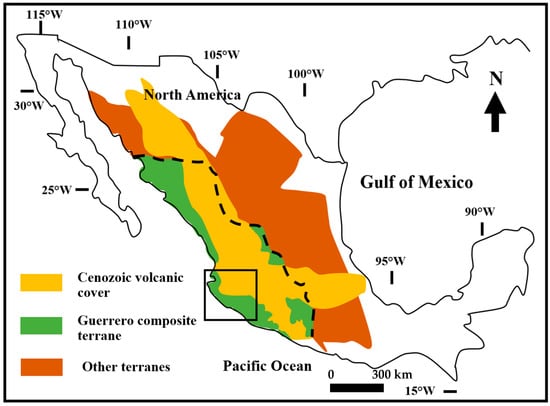
Figure 1.
Simplified Tectonostratigraphic Terranes from México [1]. The black box is the study area. The dotted line is the boundary of the covered Guerrero terrane.
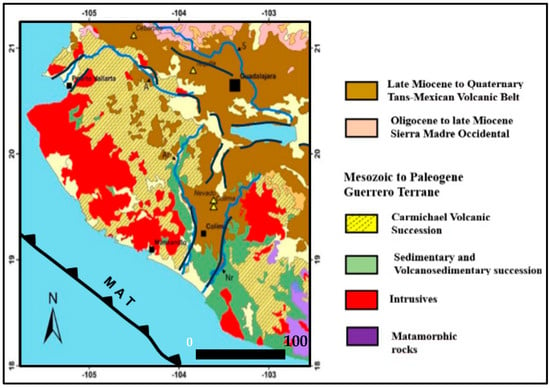
Figure 2.
Geological map of a ’slice’ of the subterrane Zihuatanejo (after Mexican Geological Service, 2007). Black thick lines are the main normal faults of the extensional boundaries of the Jalisco Block [6] and the Chapala graben. MAT, Middle American Trench.
Exploitation of the ore deposits in Mexico has occurred since the prehispanic period through artisanal methods. New mining centers were founded and developed since 1521. The Mexican Geological Service (acronym in Spanish, SGM, Servicio Geológico Mexicano) managed to obtain an aeromagnetic map of Mexico between 1962 and 2016 with the data available upon request. This information has been used to solve some structural issues [7,8,9,10,11,12,13,14,15,16], volcanic studies [6,17,18,19,20,21], and hydraulic resources [15,22,23] but a main use is devoted to the ore deposits [24,25,26,27,28,29,30,31,32,33].
In this study, we analyzed the aeromagnetic data base of the SGM to characterize the shallow structure of Jalisco in order to reveal the magnetic signature of some important Fe or Au mines as Peña Colorada and El Barqueño. We applied the methods of Baranov and Naudy [34] and Henderson [35], reduction to the pole and upward continuation methods, respectively. The Oasis software (version 9.4) was used to build the 3D models for the areas involved.
2. Geological Background
Guerrero composite terrane is located at the -western part of Mexico (Figure 1). This terrane comprises back-arc basin sequences that were tectonically accreted to the continental margin during the Laramide orogeny, spanning the Late Cretaceous to Paleogene interval [1,2,36]. The spatial distribution of Mexico’s mineral resources is the result of a complex tectonic evolution intricately linked to the sequential accretion and arrangement of tectonostratigraphic terranes. In this context, the analysis by Campa and Coney [1] emphasized the fundamental connection between the geological development of these terranes and the localization of mineral deposits across the country. A notable example of this particular configuration is the Guerrero Terrane—a Mesozoic intra-oceanic arc that was incorporated into the continental margin during the Late Cretaceous. Its versatile magmatic and structural evolution has played a major role in shaping principal metallogenic provinces.
The emplacement of intrusive rocks into carbonate-rich sequences (Figure 2) has led to the development of skarn systems enriched in iron and gold. Additionally, magmatic processes associated with the arc setting have contributed to the generation of porphyry copper deposits, particularly in deeper crustal environments. Consequent geodynamics apparently reactivated faults, fractures, while pervasive hydrothermal alteration zones have also facilitated the formation of epithermal vein systems. Therefore, an in-depth understanding of the Guerrero Terrane’s tectonostratigraphic framework is essential for guiding mineral exploration strategies and to elaborate predictive models at the regional scale.
Rosas-Elguera et al. [5] suggested that the Zihuatanejo subterrane was broken due to the normal subduction of the Rivera plate and the obliquity of the convergence of the Cocos plate, both against the Middle America Trench. This ’slice’ is the Jalisco Block. The evolution of this terrane is related to a subduction zone eastward dipping under Mexico mainland [37]. This process generated a volcanic arc and a back-arc basin to the east. The volcanic, sedimentary, and volcano-sedimentary rocks associated with these structures were consequently compressed [2].
Geologic and geochemical mapping of Mexico with mineral resources purpose was carried out by the SGM. As result, Figure 2 shows a geologic synthesis of the Jalisco Block considering the currently available database. The Triassic basement of the Arteaga complex contains a turbidite with fossil and blocks of pillow basalts and limestones. At the Jalisco Block, within the Cuale region [27,36] found pelitic schists that were correlated with the Arteaga complex. Zircons of five sites where schists outcrop around the Cuale area were dated by U-Pb method ranging 135 to 246 Ma. However, samples belonging to Cuale and Yelapa areas shows the ages as old as 1.7 Ga [38]. Overlying the Arteaga complex is the Cuale volcanic sequence ranging between 157 and 154 Ma. This magmatism includes rhyolitic flows, associated hyaloclastites, and a succession formed by sedimentary rocks (ranging from volcaniclastic conglomerates to black shales and rhyolites), which is mineralized, and granitic intrusions [27].
Parallel to the coastline, out crops the plutonic rocks which are ancient magmatic roots of a volcanic arc [36] (Figure 2). This is one of the largest batholithic bodies of the subterrane Zihuatanejo [38] indicating a substantial uplift due to the subduction and erosion processes. Valencia et al. [39] compiled its isotopic ages, giving an earlier magmatic event between 78 and 103 Ma parallel and near to the coastline. To the north, along the Tepic-Zacoalco graben, several geothermic boreholes cut intrusive rocks correlated with the Puerto Vallarta batholith [4].
Overlying the Zihuantanejo subterrane is a widespread volcanic unit. The isotopic ages reported for this unit come from Gastil et al. [40], Wallace [41], Rigther et al. [42], Rosas-Elguera et al. [43], Frey et al. [44], Valencia et al. [39] ranging between 58 and 83 Ma. Valencia et al. [39] reported that this unit is a huge Cretaceous–Paleocene ash flow tuff unit within the Jalisco Block that include a lower unit with andesitic to basaltic in composition mantled by rhyolitic units. The lithologies are welded tuffs, lithic tuffs, volcanic breccias, with thickness less than 500 m. They called it the Carmichael silicic ash flow tuff volcanic succession. We will use the terms Jalisco Block and Zihuatanejo subterrane indistinctly.
3. Mineral Resources: Gold and Iron
Several ways to explain the distribution of mineral resources in Mexico have been proposed. Salas [45] proposed the limitation as a function of physiographic provinces. Damon et al. [46] related the distribution with the subduction zone while Campa and Coney [1] suggested a relationship with the evolution of the tectonostratigraphic terranes. More recently, Camprubí [47] followed the same idea but from metallogenic point of view along the Pacific margin province. Figure 3 shows that in western Mexico, the distribution of the Au and Fe deposits follow the present-day coastline, to the west of the Sierra Madre Occidental and covering the same area as the batholitic rocks, respectively. The present study magnetically analyzes two major mineral deposits in this sector: El Barqueño (gold) and Peña Colorada (iron).
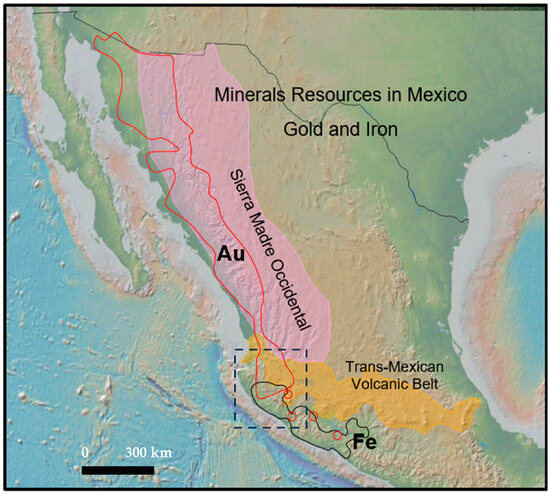
Figure 3.
Mineral resources in Mexico: Gold and Iron. These areas are not the only one but there are related with our study area (discontinuous box). Red circle, El Barqueño, black box Peña Colorada.
4. Aeromagnetic Data
In recent decades, the mining industry has undergone significant transformation thanks to the advancement of emerging technologies. Among these, the use of drones or Unmanned Aerial Vehicles (UAVs) has become a key tool for improving efficiency, safety, and precision in the mineral exploration. Drones enable the rapid and high-resolution collection of topographic, geological, geomagnetic and environmental data. Equipped with multispectral cameras, LiDAR sensors, or thermal imaging, may cover large areas and capture valuable information without the need for direct human presence in inaccessible or potentially hazardous zones [48,49]. This approach not only reduces operational costs but also minimizes the human risks.
One of the main advantages of using drones in mineral exploration is their ability to generate 3D digital terrain models, orthomosaic maps, high accuracy contour lines and magnetic maps. This information is essential during the early stages of a project, as it helps identify geological structures, surface alterations and potential mineralized zones more clearly and in less time than traditional methods.
The analysis of the magnetic properties of materials has been applied to different kind of research using novel technologies. Drone technology is also useful to obtain data at low altitude with high resolution and reduced cost. These new techniques were applied not only in mining but also for to agricultural purposes [50] and archeological goals [51,52].
Aeromagnetic data over the Jalisco Block was acquired in 1983 by the Consejo de Recursos Minerales (CRM, now the SGM) as part of a regional geophysical prospection. The survey used a Britten-Norman Islander BN2-B27 aircraft (Britten-Norman, Isle of Wight, UK), equipped with a Geometrics G-803 proton precession magnetometer featuring a sensitivity of 0.25 nanoteslas (nT). Data acquisition was carried out using a Geometrics G-704 recording system. In addition, a Geometrics G-826A magnetometer (Geometrics, San Jose, CA, USA), with a sensitivity of 1 nT, was deployed at the base station to monitor and correct for temporal variations in the Earth’s magnetic field.
The aircraft was also outfitted with a Sperry RT-220 radar altimeter for maintaining consistent flight altitude, a visual navigation system to guide flight paths, and a 35 mm Automax photographic camera to document surface conditions and aid in navigation.
A reconnaissance flight parameter was designed to optimize magnetic coverage and resolution. Contour-following flights were conducted at an average terrain clearance of approximately 300 m. The orientation of the flight lines was northeast, with an azimuth of 30°, and a spacing of 1000 m between adjacent lines, allowing for comprehensive regional coverage. Northwest control lines every 10,000 m were also flown.
Aeromagnetic Interpretation
Post-acquisition data processing included digital compilation and corrections for aircraft motion (magnetic compensation), as well as the removal of diurnal magnetic variations recorded at the base station. To isolate the local geological magnetic anomalies, the Total Magnetic Field (TMF) measurements were corrected by subtracting the International Geomagnetic Reference Field (IGRF) model. The result was a Residual Magnetic Field (RMF) dataset, which reveals the magnetic signature of subsurface geological structures (Figure 4A).
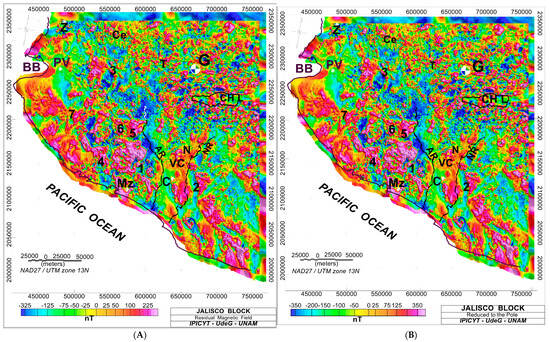
Figure 4.
(A) Shows the contour maps of the Residual Magnetic Field, and (B) the Reduced-to-the-Pole Magnetic Field. G = Guadalajara; PV = Puerto Vallarta; BB = Bahía de Banderas; Mz = Manzanillo; C = Colima; Volcanoes: VC = Colima; N = Nevado; T = Tequila; C = Ceboruco; Rivers: Ar = Armería; Nr = Naranjo. Mines: 1 = Peña Colorada; 2 = Encino; 3 = El Barqueño; 4 = La Huerta; 5 = El Grullo; 6 = Autlán; 7 = Cuale.
To observe the surface structure of the Jalisco Block (JB) at depths on the order of 20 km and related ore deposits, the first step was to obtain the Residual Magnetic Field (RMF) (Figure 4A), which was derived by applying the International Geomagnetic Reference Field (IGRF) to the Total Magnetic Field (TMF). Subsequently, the RMF values obtained were processed using the Baranov and Naudy [34] filter to generate the Reduced-to-the-Pole (RTP) Magnetic Field (Figure 4B). This RTP field was then subjected to the Henderson [35] filter, with upward continuations at 1, 3, 5, 10, and 20 km (Figure 4, Figure 5, Figure 6 and Figure 7). This procedure eliminated all short wavelengths and high frequencies, allowing how the shallow crustal of the JB changes as depth increases, making possible to identify sources (intrusives) associated with mineralization.
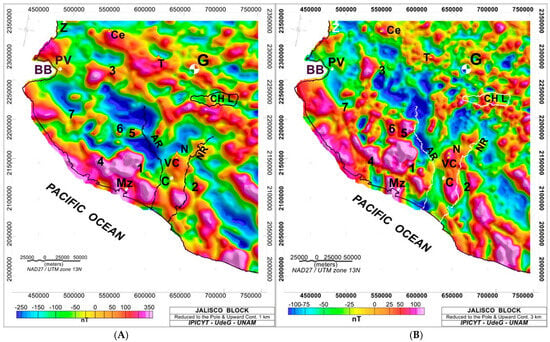
Figure 5.
(A) Shows the contour map of the Reduced-to-the-Pole (RTP) Magnetic Field with 1 km Upward Continuation (UC). (B) shows the RTP with 3 km UC. G = Guadalajara; PV = Puerto Vallarta; BB = Bahía de Banderas; Mz = Manzanillo; C = Colima; Volcanoes: VC = Colima; N = Nevado; T = Tequila; C = Ceboruco; Rivers: Ar = Armería; Nr = Naranjo. Mines: 1 = Peña Colorada; 2 = Encino; 3 = El Barqueño; 4 = La Huerta; 5 = El Grullo; 6 = Autlán; 7 = Cuale.
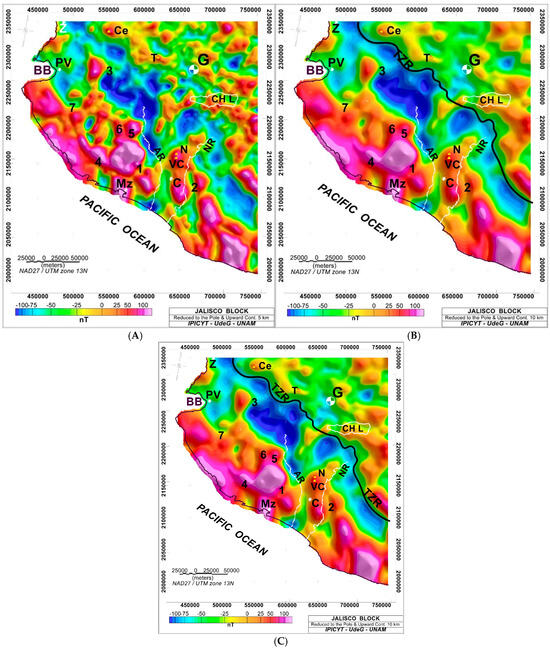
Figure 6.
(A) Shows the configuration of the Reduced-to-the-Pole (RTP) Magnetic Field with 5 km Upward Continuation (UC). (B) shows the RTP with 10 km UC. G = Guadalajara; PV = Puerto Vallarta; BB = Bahía de Banderas; Mz = Manzanillo; C = Colima; Volcanoes: VC = Colima; N = Nevado; T = Tequila; C = Ceboruco; Rivers: Ar = Armería; Nr = Naranjo. Mines: 1 = Peña Colorada; 2 = Encino; 3 = El Barqueño; 4 = La Huerta; 5 = El Grullo; 6 = Autlán; 7 = Cuale. (C) Shows the contour map of the Reduced to the Pole (RTP) Magentic Field with 10 km Upward Continuation (UC). It also shows the northern limit (solid black line) of the Jalisco Block, represented by the southern boubdary of the Tepic-Zacoalco Rift (TZR).
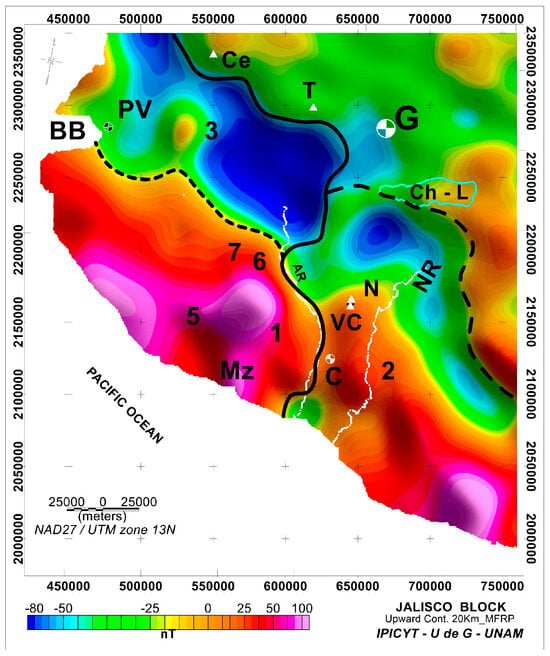
Figure 7.
The contour map of the RP and Upward Continuation 20 km is shown. It also shows the northern limit (solid black line) of the Jalisco Block. The dashed line with short segment indicates the boundary of the Puerto Vallarta Batholith, while the dashed line with long segments shows the continuation of the TZR.
Aeromagnetic anomalies outline distinct patterns with tectonic characteristics. In western Mexico, the high-frequency and high-amplitude dipolar anomalies that characterize the JB contrasts with the aeromagnetic response of the blocks to the east of Colima graben and to the north of Tepic-Zacoalco rift. The JB boundaries can be distinguished based on its aeromagnetic signature.
In Figure 5A, the Reduced-to-the-Pole (RTP) field with 1 km upward continuation (UC) can be observed. The amplitudes toward the western portion are greater than those toward the north and somewhat similar to those in the southeastern portion of the mapped area. In Figure 5B (RTP UC 3 km), magnetic anomalies associated with intrusive bodies and related to mineralization can be more clearly distinguished. The boundaries of the Jalisco Block (JB) begin to take shape based on anomalies associated with magnetic lows.
In Figure 6A (UC 5 km), volcanic structures (Colima, Tequila, and Ceboruco volcanoes) are associated with monopolar magnetic anomalies. We identified two main areas with distinct magnetic signatures that become more defined with increasing depth—both are subparallel to the southwestern coastline of Mexico (Figure 6 and Figure 7). The northern area, characterized by low magnetic values, exhibits a NW–SE orientation. At depths of 10 and 20 km, however, these anomalies no longer reflect the presence of magnetic materials (Figure 6 and Figure 7). We interpret this magnetic response to be associated with volcano-sedimentary sequences. At these depths, the northern boundary of the Jalisco Block—marked by the Tepic-Zacoalco Rift—is also clearly delineated (Figure 6 and Figure 7).
In contrast, the southern region is defined by high magnetic anomalies, which we interpret as the response of intrusive rocks, likely representing the roots of an ancient volcanic arc. This area hosts several iron ore deposits, including the El Encino and Peña Colorada mines. The magnetic maxima associated with the Colima Volcanic Complex remain detectable even at depths of 10 and 20 km and appear to separate two intrusive bodies (Figure 6 and Figure 7). This pattern can be explained by the presence of a fault zone between these intrusives, which likely facilitated magma ascent and the subsequent formation of the Colima Volcanic Complex.
In the south-central portion, there is an anomaly associated with a mineralizing intrusive body, with iron ore mineralization along its eastern and western contacts, and gold, silver, and manganese mineralization to the north.
In Figure 6C (UC 10 km), the batholith of the Jalisco Block (JB) is clearly delineated, extending from the coastline toward the central portion of the area. It is bounded to the north and east by anomalies associated with magnetic lows, and to the west by the Bahía de Banderas.
In Figure 7 (UC 20 km), the boundaries of the Jalisco Block (JB) are well defined, located at the transition between magnetic highs and lows. The Fe mineralization (1, 2, and 4) is situated along the gradient of positive anomalies, while the Au, Ag, and Mn mineralization lies on the magnetic high. Figure 7 also shows a decrease in magnetization intensity within the Colima graben, which can be interpreted as a batholith divided into two parts: one to the northwest of the Armería River and the other to the southeast of the Naranjo River.
5. Magnetic Anomaly Modeling
The inversion model was based on the Residual Magnetic Field (RMF) of the Jalisco Block using a conventional root mean square (RMS) misfit value of 5 nT. The 3D magnetic inversion was performed using the VOXI Earth Modeling software (Oasis montaje 9.4) with the Magnetization Vector Inversion (MVI) method. The model domain consisted of a voxel grid with 100 cells in the X direction, 104 in Y, and 30 in Z, totaling 312,000 data points. The inversion was constrained using a digital elevation model (DEM), with standard settings for both minimum regularization and depth weighting. The topographic elevation in the study area ranges between 2723 and 2933 m above sea level (m.a.s.l.).
The inversion was performed with the VOXI module in the Oasis Montaj software version 9.4 (Figure 8 and Figure 9). This platform employs a Cartesian Cut Cell (CCC) approach combined with an Iterative Reweighting Inversion (IRI) algorithm, originally developed by Ingram et al. [53] and later simplified by Ellis and MacLeod [54,55]. The CCC method allows accurate representation of geological surfaces by slicing voxel boundaries, while the IRI technique iteratively refines an initial Earth model, focusing broad, low-amplitude anomalies into more compact and higher-amplitude magnetic positive anomalies
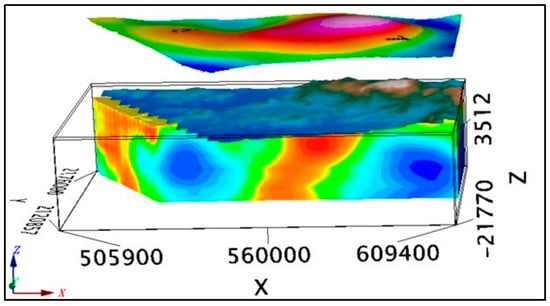
Figure 8.
The subsurface magnetic contour shows, in its central portion, the presence of an elongated anomaly slightly inclined eastward, which is correlated with the mineralization source.
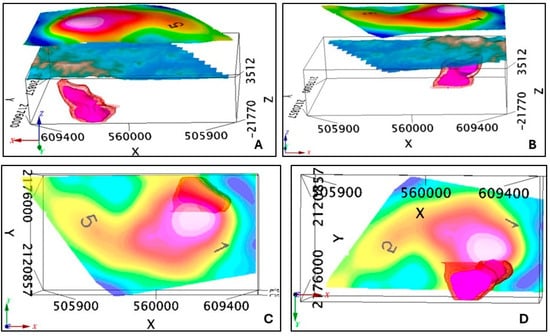
Figure 9.
Three-dimensional VOXI models associated with two isosurfaces with magnetic susceptibilities of 0.03 SI (pink) and 0.01 SI (red). Shown are (A) a view to the south; (B) a view to the north; (C) a top-down view; and (D) a bottom-up view. The coordinate system displays the north direction as a green vector. Numbers 1 and 5 indicate the locations of the Fe mines Peña Colorada and La Huerta, respectively.
The magnetic properties associated with the anomalies were modeled using a polygonal assembly with different magnetizations. A major limitation in this analysis is the lack of data on how magnetic properties vary with the depth. To better constrain the sources’ morphology, 3D modeling of magnetic susceptibility was performed using Geosoft’s VOXI software (version 9.4) and the MVI technique [54,55]. MVI treats both the amplitude and direction of magnetization as separate unknowns and uses magnetic susceptibility as a scalar proxy. Ellis et al. (2012) [54] provides a detailed explanation of the MVI method, which employs voxel-based 3D inversion with Tikhonov [56] minimum gradient regularization.
For the magnetic subsurface contour map and the generation of the VOXI model, a total of 1,160,632 data points were used, distributed along the X = 218, Y = 121, and Z = 44 data (Figure 8 and Figure 9). To model the aeromagnetic response, data were upward continued by 10 km and extended down to a depth of 20 km.
The VOXI model was generated using four isosurfaces: two associated with the mineralization source, with magnetic susceptibilities of 0.03 SI (pink) and 0.01 SI (red), and other two corresponding to the host rocks, with susceptibilities of 0.001 SI (green) and 0.0001 SI (yellow). The source body (pink) exhibits dimensions of 23.8 km in the X direction (coordinates 594,313 to 570,520); 17.1 km in the Y direction (2,175,000 to 2,157,885); and 15.1 km in the Z direction (−6638–−21,769). This isosurface has an approximate area of 928.8 km2 and a volume of 1359.2 km3. The second mineralization-related source (red isosurface) measures 29.9 km in the X direction (596,853 to 537,448); 18.9 km in Y (2,175,000 to 2,156,099); and Z 18.1 km (−3669–−21,759). It shows an area of 1561 km2 and an approximate volume of 3383 km3 (Figure 9).
The other two isosurfaces used in the modeling represent the host rocks. One of the isosurfaces representing the host rocks has a magnetic susceptibility of 0.001 SI (green) and spans 80 km in the X direction (coordinates 607,000 to 526,972); 54.5 km in Y (2,175,500 to 21,210,000); and 20.2 km in Z (from −1605 to −21,769 m). This isosurface has an approximate area of 4395.4 km2 and a volume of 11,503.8 km3. The second host body, associated with the 0.0001 SI susceptibility isosurface (yellow), measures 101 km in X (609,000 to 508,000); 54.5 km in Y (2,175,500 to 212,000); and 23.8 km in Z (from 2023 to −21,769 m). This isosurface has an approximate area of 10,697.8 km2 and a volume of 30,800 km3 (Figure 10).


Figure 10.
Three-dimensional VOXI models associated with two isosurfaces corresponding to host rocks, with magnetic susceptibilities of 0.001 SI (green) and 0.0001 SI (yellow). Shown are (A) a view to the south; (B) a view to the north; (C) a top-down view; and (D) a bottom-up view. The coordinate system displays the north direction as a green vector. Numbers 1 and 5 indicate the locations of the Fe mines Peña Colorada and La Huerta, respectively.
6. Concluding Remarks
- Complex Geodynamic Evolution and Associated Mineralization.The long-term interaction between the North American and Farallon tectonic plates along a subduction zone led to the accretion of tectonostratigraphic terranes and the formation of numerous mineral deposits, particularly in southwestern Mexico (Figure 11). Under these particular geodynamic configurations, the Guerrero Terrane and the Jalisco Block represent key regions for mineral exploration.
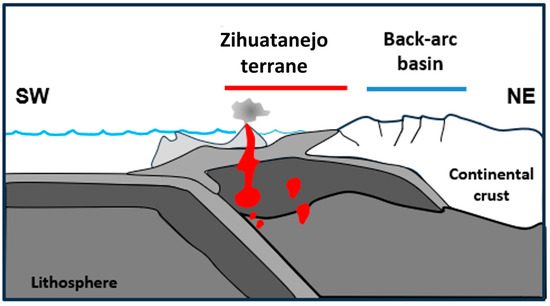 Figure 11. Modified from Valencia et al. [39] to depict a Late Cretaceous scenario of western Mexico. This view can explain the magnetic response of the shallow crust observed in our study (After [39]).
Figure 11. Modified from Valencia et al. [39] to depict a Late Cretaceous scenario of western Mexico. This view can explain the magnetic response of the shallow crust observed in our study (After [39]). - Metallogenic Significance of the Guerrero Terrane.The structural and magmatic evolution of the Guerrero Terrane—including the emplacement of intrusive rocks into carbonate-rich sequences—favored the development of iron- and gold-rich skarn systems, porphyry-type deposits, and epithermal vein systems. A better understanding of this terrane is essential for the construction of predictive metallogenic models and the planning of future exploration strategies.
- Geological and Structural Delimitation of the Jalisco Block.Aeromagnetic data, combined with processing techniques such as reduction to the pole and upward continuation, enabled the structural delineation of the Jalisco Block. These methods revealed well-defined structural boundaries and magnetic contrasts between lithologically and mineralogically distinct zones.
- Effective Application of Modern Geophysical Technologies.The integration of aeromagnetic surveys and 3D aeromagnetic modeling facilitated high-resolution subsurface characterization at reduced operational costs. These technologies enabled the identification of intrusive bodies associated with Fe and Au mineralization, as exemplified by the Peña Colorada and El Barqueño deposits.
- Correlation Between Magnetic Anomalies and Mineralization.Positive magnetic anomalies in the southern portion of the Jalisco Block are associated with deep-seated intrusions interpreted as the roots of an ancient volcanic arc. These anomalies spatially coincide with known Fe and Au deposits and remain detectable at depths of up to 20 km, underscoring the role of such intrusive in mineralizing processes. The aeromagnetic survey over the Jalisco Block reveals at least two clearly contrasting zones in the upward continuations (Figure 7 and Figure 8). One of them (toward the south) is characterized by positive anomalies extending from Bahía de Banderas to the Armería River. This zone is closely correlated with the Puerto Vallarta Batholith, emplaced during the Late Cretaceous. Some areas of this intrusive body are associated with iron (Fe) mineralization and magnetic anomalies. In some cases, they are also linked to Au–Ag and Mn mineralization. The northern section of the Jalisco Block, as seen in the aeromagnetic data, is characterized by negative magnetic anomalies over volcanic and volcanosedimentary rocks that extend southward into the Sierra Madre Occidental. The RMF and RP signature delineated the continental boundaries of the Jalisco Block. The high-frequency and high-amplitude dipolar anomalies that characterize the JB contrasts with the aeromagnetic response of the blocks to the east of Colima graben and to the north of Tepic-Zacoalco graben. As deeper zones are concerned, our ascending trends, lower than 20 km (Figure 3, Figure 4 and Figure 5), show a remarkable NW–SE magnetic low that we interpret as the back-arc basin developed in the Triassic period and accreted to Mexico mainland in the Late Cretaceous period (Figure 10). Furthermore, the magnetic maxima would be related to the Puerto Vallarta batholith, the roots of the volcanic arc suggested by Valencia et al. [39] as is shown in Figure 9.
- 3D Magnetic Modeling as a Tool for Exploration.The 3D inversion of the Residual Magnetic Field using the Magnetization Vector Inversion (MVI) method allowed for the visualization of the geometry and depth of mineralized bodies. This modeling highlighted zones of high magnetic susceptibility associated with significant mineralization, thereby enhancing the predictive capabilities of exploration programs.
Author Contributions
Conceptualization, H.L.L. and J.R.-E.; methodology, H.L.L. and A.G.; software, H.L.L.; validation, H.L.L., J.R.-E. and A.G. All authors have read and agreed to the published version of the manuscript.
Funding
This research received no external funding.
Data Availability Statement
Available on reasonable request.
Conflicts of Interest
The authors declare no conflict of interest.
References
- Campa, M.F.; Coney, P.J. Tectonostratigraphic terranes and mineral resource distributions in Mexico. Can. J. Earth Sci. 1983, 26, 1040–1051. [Google Scholar] [CrossRef]
- Centeno-García, E.; Guerrero-Suastegui, M.; Talavera-Mendoza, O. The Guerrero Composite Terrane of western Mexico: Collision and subsequent rifting in a supra-subduction zone. Geol. Soc. Am. Pap. 2008, 436, 279–308. [Google Scholar]
- Centeno-García, E.; Busby, C.; Busby, M.; George Gehrel, G. Evolution of the Guerrero composite terrane along the Mexican margin, from extensional fringing arc to contractional continental arc. Geol. Soc. Am. Bull. 2011, 436, 279–308. [Google Scholar] [CrossRef]
- Ferrari, L.; Rosas-Elguera, J. Late Miocene to Quaternary extension at the northern boundary of the Jalisco block, western Mexico: The Tepic-Zacoalco rift revised. Geol. Soc. Am. Spec. Pap. 2000, 334, 41–64. [Google Scholar]
- Rosas-Elguera, J.; Ferrari, L.; Gardunño-Monroy, V.H.; Urrutia-Fucugauchi, J. Continental boundaries of the Jalisco block and their influence in the Pliocene-Quaternary kinematics of western Mexico. Geology 1996, 24, 921–924. [Google Scholar] [CrossRef]
- Sharpe, D.J.A. Aeromagnetometry as a Primary Reconnaissance Tool. Shale Shak. Dig. I 1955, I–V, 8. [Google Scholar]
- Almaguer, J.; Lopez-Loera, H.; Macias, J.L.; Saucedo, R.; Yutsis, V.; Guevara, R. Geophysical modeling of La Primavera caldera and its relation to volcanology activity based on 3D susceptibility inversion and potential data analysis. J. Volcanol. Geotherm. Res. 2020, 393, 106556. [Google Scholar] [CrossRef]
- Alvarez, R.; López-Loera, H.; Arzate, J. Modeling the marine magnetic field of Bahía de Banderas, Mexico, confirms the half-graben structure of the bay. Tectonophysics 2010, 489, 14–28. [Google Scholar] [CrossRef]
- Bandy, W.; Kostoglodov, V.; Díaz, A.H.; Mena, M. Structure of the southern Jalisco subduction zone, Mexico, as inferred from gravity and seismicity. Geofísica Int. 1999, 38, 127–136. [Google Scholar]
- Bettucci, L.S.; Loureiro, J.; Demarco, P.N. Airborne geophysical characterization of Uruguayan basement. J. S. Am. Earth Sci. 2021, 108, 103206. [Google Scholar] [CrossRef]
- Broenner, M.; Olesen, O.; Myklebust, R.; Rønning, J.; Dumais, M.A.; Baranwal, V.C.; Gernigon, L.; Gradmann, S.; Gellein, J.; Haase, C.; et al. Acquisition and Application of Aero-Magnetometry in Norway and on the Norwegian Shelf. In Marine Acquisition Workshop; European Association of Geoscientists & Engineers: Utrecht, The Netherlands, 2018; p. cp-560-00001. [Google Scholar]
- Echarte, M.E.P.; Morán, O.R.; González, J.M.; de la Fuente, L.J. Geological-Structural Mapping and Favorable Sectors for Oil and Gas in Cuba: Non-Seismic Exploration Methods; Springer Nature: Cham, Switzerland, 2022. [Google Scholar]
- Esquinca, M.D.O.R.; Miranda, C.A.C.; Hernández, E.M.; Flores, E.R.H. Los métodos potenciales como evidencia geofísica de la evolución tectónica del norte del Golfo de México. Pet. Ing. 2013, 53, 89–100. [Google Scholar]
- Fucugauchi, J.U. Spatial and temporal magnetic anomalies of Colima volcano, western Mexico. Geofísica Int. 1999, 38, 3–16. [Google Scholar]
- López-Loera, H.; Tristán-González, M. Geología y magnetometría aérea del Graben de Villa de Reyes, San Luis Potosí, Mesa Central de México: Implicaciones tectónicas y geohidrológicas. Boletín Soc. Geológica Mex. 2013, 65, 137–156. [Google Scholar] [CrossRef]
- López-Loera, H.; Espíndola, J.M.; Macías, J.L.; Torres-Gaytan, D.E. Internal structure of the southern and central Colima Volcanic Complex, western Mexico, revealed by 3D modeling of aeromagnetic data. J. S. Am. Earth Sci. 2024, 136, 104682. [Google Scholar] [CrossRef]
- Almaguer, J.; Guevara-Betancourt, R.; Sieck, P.; Aguillón-Robles, A.; Lopez-Loera, H.; Cerca-Ruiz, M.F.; Tristán-González, M. An integrated geophysical and geological 3D model to characterize the feeder system of La Joya Honda and La Joyuela maars complex in central Mexico. J. S. Am. Earth Sci. 2023, 125, 104254. [Google Scholar] [CrossRef]
- Cherkasov, S.V.; Sterligov, B.V.; Zolotaya, L.A. On the use of unmanned aerial vehicles for high-precision measurements of the Earth’s magnetic field. Mosc. Univ. Geol. Bull. 2016, 71, 296–299. [Google Scholar] [CrossRef]
- de Oliveira Chaves, A.; da Cruz Pires, A.C.; Brasil, M.F.A. New knowledge update on mafic dyke swarms of Minas Gerais (Brazil): Fragments of ancient large igneous provinces highlighted by aeromagnetometry. Braz. J. Geophys. 2021, 39, 227–235. [Google Scholar] [CrossRef]
- López-Loera, H. 2 ¾ dimension modeling of the aeromagnetic anomaly of Volcán de Colima, western Mexico. Geofísica Int. 2012, 51, 129–142. [Google Scholar] [CrossRef]
- Ventura, K.; Alvarenga, K.; Mayén, A. Advancing Geothermal Exploration in El Salvador: Development and Application of a UAV Aeromagnetometry Methodology. In Proceedings of the Second EAGE Workshop on Geothermal Energy in Latin America, Guanacaste, Costa, 15–17 November 2023; European Association of Geoscientists & Engineers: Utrecht, The Netherlands, 2023; Volume 2023, pp. 1–5. [Google Scholar]
- Barcellos, J.D.S.G.; de Almeida Pires, C.; Pinheiro, H.S.K.; Szameitat, L.S.A.; Tesser, L.R.; de Oliveira Gomes, O.V.; Miranda, A.W.A. Geomorphometry and aeromagnetometry as water management tools: A case study in hydrological planning units in southeastern Brazil. J. S. Am. Earth Sci. 2024, 133, 104725. [Google Scholar] [CrossRef]
- Pinéo, T.R.G.; Branco, R.M.G.C.; da Cunha, L.S.; Souza, M.L. Airborne and ground geophysics applied to groundwater prospection in hard rocks in Iraucuba, Ceara state, Brazil. Braz. J. Geophys. 2013, 31, 699–709. [Google Scholar] [CrossRef][Green Version]
- Alva-Valdivia, L.M.; López-Loera, H. A review of iron oxide transformations, rock magnetism and interpretation of magnetic anomalies: El Morro Mine (Brazil), a case study. Geofísica Int. 2011, 50, 341–362. [Google Scholar] [CrossRef]
- Baldin, M.T.; Salamuni, E.; De Castro, L.G. Aeromagnetometria e aerogamaespectrometria do Complexo Atuba e arredores, leste do estado do Paraná. Geol. USP Série Científica 2020, 20, 137–152. [Google Scholar] [CrossRef]
- Barros Camara, E.D.; Pereira Guimarães, S.N. Magnetic airborne survey–geophysical flight. Geosci. Instrum. Methods Data Syst. Discuss. 2016, 5, 181–192. [Google Scholar] [CrossRef]
- Bissig, T.; Mortensen, J.K.; Tosdal, R.M.; Hall, B.V. The rhyolite-hosted volcanogenic massive sulfide district of Cuale, Guerrero terrane, west-central Mexico: Silver-rich base metal mineralization emplaced in a shallow marine continental margin setting. Econ. Geol. Bull. Soc. Econ. Geol. 2008, 103, 141–159. [Google Scholar] [CrossRef]
- Estrada Barraza, S. Experiencias en la prospección mineral mediante la verificación geológica de anomalías aeromagnéticas. Geomimet 2016, 43, 15–19. [Google Scholar]
- Hartmann, L.A.; Lopes, W.R.; Savian, J.F. Integrated evaluation of the geology, aerogammaspectrometry and aeromagnetometry of the Sul-Riograndense Shield, southernmost Brazil. An. Acad. Bras. Ciências 2016, 88, 75–92. [Google Scholar] [CrossRef]
- Hartmann, L.A.; Massuda, A.J.; Cerva-Alves, T.; Lana, C.; Leandro, C.G.; Savian, J.F. Aeromagnetometry and aerogammaspectrometry integrated with U-Pb zircon geochronology of northern Bossoroca ophiolite, Brasiliano Orogen. An. Acad. Bras. Ciências 2021, 93, e20190791. [Google Scholar] [CrossRef] [PubMed]
- Hernandez-Perez, I.; Lara-Sanchez, J.; Campos-Enriquez, J.O. Aeromagnetic map to prove Mexico’s mining potential. Lead. Edge 1998, 17, 1085–1086. [Google Scholar] [CrossRef]
- Madrid, F.G.; Fries, M.; dos Santos, B.M.L.; dos Reis Luiz, H. Exploration and assessment of iron occurrences-A case study applying airborne geophysics and GIS allied to field magnetic susceptibility measurements. J. S. Am. Earth Sci. 2025, 153, 105351. [Google Scholar] [CrossRef]
- Reford, M.S.; Sumner, J.S. Aeromagnetics. Geophysics 1964, 29, 482–516. [Google Scholar] [CrossRef]
- Baranov, V.; Naudy, H. Numerical calculation of the formula of reduction to the magnetic pole. Geophysics 1964, 29, 67–79. [Google Scholar] [CrossRef]
- Henderson, R.G. On the validity of the use of the upward continuation integral for total magnetic intensity data. Geophysics 1970, 35, 916–919. [Google Scholar] [CrossRef]
- Calmus, T.; Poupeau, G.; Bourgois, J.; Michaud, F.; Mercier de Lépinay, B.; Labrin, E.; Azdimousa, A. Late Mesozoic and Cenozoic thermotectonic history of the Mexican Pacific margin (18 to 25° N): New insight from apatite and zircon fission-tracks analysis of coastal and offshore plutonic rocks. Tectonophysics 1999, 306, 163–182. [Google Scholar] [CrossRef]
- Stock, J.M. Tectónica de placas y evolución del Bloque Jalisco, México. GEOS Bol. Union Geofís. Mex. 1993, 13, 3–9. [Google Scholar]
- Schaaf, P.; Moran, Z.D.; Hernandez, B.M.S.; Pichardo, S.G.; Tolson, G.; Köhler, H. Paleogene continental margin truncation in southwestern Mexico. Geochronol. Evid. Tecton. 1995, 14, 1339–1350. [Google Scholar]
- Valencia, V.A.; Righter, R.; Rosas-Elguera, J.; Lopez-Martínez, M.; Grove, M. The age and composition of the pre-Cenozoic basement of the Jalisco Block: Implications for and relation to the Guerrero composite terrane. Contrib. Mineral. Petrol. 2013, 166, 801–824. [Google Scholar] [CrossRef]
- Gastil, G.; Krummenacher, D.; Jensky, W.A. Reconnaissance Geology of West-Central Nayarit, Mexico; Geological Society of America Map and Chart Series MC-24, map 1:200,000; Geological Society of America Bulletin: Boulder, CO, USA, 1978. [Google Scholar]
- Wallace, P.; Carmichael, S.E. Alkaline and calc-alkaline lavas near Los Volcanes, Jalisco, Mexico: Geochemical diversity and its significance in volcanic arcs. Contrib. Mineral. Petrol. 1992, 111, 423–439. [Google Scholar] [CrossRef]
- Righter, K.; Carmichael, I.S.E.; Becker, T.A. Renne RP Pliocene to Quaternary volcanism and tectonism at the intersection of the Mexican Volcanic Belt and the Gulf of California. Geol. Soc. Am. Bull. 1995, 107, 612–626. [Google Scholar] [CrossRef]
- Rosas-Elguera, J.; Ferrari, L.; Lopez-Martinez, M.; Urrutia-Fucugauchi, J. Stratigraphy and tectonics of the Guadalajara region and the triple junction area, western Mexico. Int. Geol. Rev. 1997, 39, 125–140. [Google Scholar] [CrossRef]
- Frey, H.M.; Lange, R.A.; Hall, C.M.; Delgado-Granados, H. Magma eruption rates constrained by 40Ar/39Ar chronology and GIS for the Ceboruco-San Pedro volcanic field, western Mexico. Geol. Soc. Am. Bull. 2004, 166, 259–276. [Google Scholar] [CrossRef]
- Salas, G.P. Contribution of Mexico to the Metallogenetic Chart of North America; Geological Society of America: Boulder, CO, USA, 1975; Map MC-13. [Google Scholar]
- Damon, P.E.; Shafiqullah, M.; Clark, K.F. Evolución de los arcos magmáticos en México y su relación con la metalogénesis. Rev. Mex. Cienc. Geológicas UNAM 1981, 5, 131–139. [Google Scholar]
- Camprubí, A. Major metallogenic provinces and epochs of Mexico. SGA News 2009, 25, 1–21. [Google Scholar]
- Meng, X.; Zhang, D.; Dong, S.; Yao, C. Open-pit granite mining area extraction using UAV aerial images and the novel GIPNet. Remote Sens. 2024, 16, 789. [Google Scholar] [CrossRef]
- Stothard, P.; Shirani Faradonbeh, R. Application of UAVs in the mining industry and towards an integrated UAV-AI-MR technology for mine rehabilitation surveillance. Min. Technol. 2023, 132, 65–88. [Google Scholar] [CrossRef]
- Rani, I. Magnetic-Powered Mini Drones for Smart IOT-Driven Agricultural Solutions. Int. J. Adv. Res. Interdiscip. Sci. Endeav. 2025, 2, 550–560. [Google Scholar] [CrossRef]
- Accomodo, F.; Florio, G. Drone-Borne Magnetic Gradiometry in Archaeological Applications. Sensors 2024, 24, 4270. [Google Scholar] [CrossRef]
- Kaub, L.; Stele, A.; Linck, R.Y.; Fassbinder, J. Levantamiento magnético para arqueología con drones. Resúmenes Reun. Otoño AGU 2023, 2023, NS43A-05. [Google Scholar]
- Ingram, D.M.; Causon, D.M.; Mingham, C.G. Developments in Cartesian cut cell methods. Math. Comput. Simul. 2003, 61, 561–572. [Google Scholar] [CrossRef]
- Ellis, R.G.; Wet, B.; Macleod, I.N. Inversion of magnetic data from remanent and induced sources, magnetization vector inversion of the Pirapora anomaly. In Proceedings of the Fourteenth International Congress of the Brazilian Geophysical Society 6, 22nd International Geophysical Conference and Exhibition, Rio de Janeiro, Brazil, 3–6 August 2012. [Google Scholar]
- Ellis, R.; MacLeod, I. Constrained voxel inversion using the Cartesian Cut Cell method. In Proceedings of the 23rd International Geophysical Conference and Exhibition, Melbourne, VIC, Australia, 11–14 August 2013; pp. 1–4. [Google Scholar]
- Tikohonov, A.N. Solution of incorrectly formulated problems and the regularization method. Sov. Math. Dokl. 1963, 4, 1035–1038, English translation of Dokl. Akad. Nauk. SSSR 151, 501–504. [Google Scholar]
Disclaimer/Publisher’s Note: The statements, opinions and data contained in all publications are solely those of the individual author(s) and contributor(s) and not of MDPI and/or the editor(s). MDPI and/or the editor(s) disclaim responsibility for any injury to people or property resulting from any ideas, methods, instructions or products referred to in the content. |
© 2025 by the authors. Licensee MDPI, Basel, Switzerland. This article is an open access article distributed under the terms and conditions of the Creative Commons Attribution (CC BY) license (https://creativecommons.org/licenses/by/4.0/).